Whether you’re enjoying a slice of this traditional pound cake on its own as a treat or with a cup of coffee for breakfast, you will always want a second slice. While heavy and dense, this classic pound cake recipe is shockingly moist with a soft and smooth crumb. The flavors are perfectly balanced as it’s not overwhelmingly sweet so that you can enjoy it any time of the day. You will love the subtle vanilla flavoring and the tanginess from the sour cream.
Far from boring, this cake is perfect for any occasion as it keeps and travels well. For another simple but delicious treat that everyone will love, try my butter cake recipe, chiffon cake recipe, or orange cake recipe.
What You Need to Make This Recipe
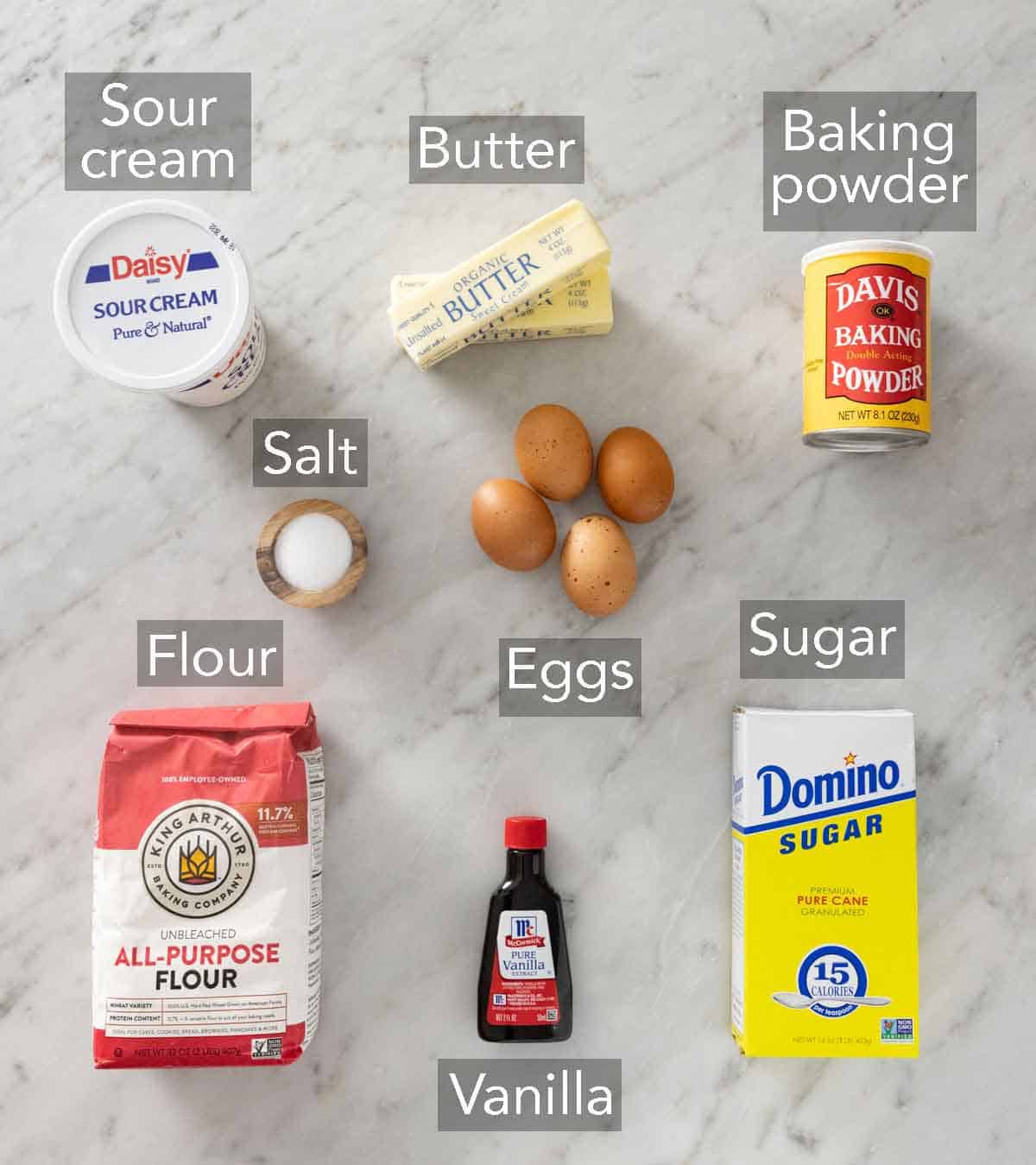
Flour — all-purpose flour is all you need to make a delightfully tender and buttery pound cake. Some recipes call for cake flour, and you can certainly use that if you’d prefer. Sub 1 cup plus 2 tablespoons of it for AP if measuring with scoops. If measuring by weight, the gram amount is that same!
Butter — make sure you bring the butter to room temperature for the cake batter, which means it’s soft enough so when you press into it, your finger leaves a dent, but not too soft that it’s greasy or oily. Room temperature creams much better than cold butter. Also, make sure to buy unsalted butter to ensure the cake doesn’t turn out too salty.
Sugar — I do not recommend swapping out or decreasing the amount of sugar. You will need the entire cup to cream the butter and sweeten the cake.
Eggs — this recipe calls for four eggs. The eggs keep the pound cake moist and assist the baking powder in helping the cake rise. As the eggs mix into the batter, they create air bubbles that expand in the oven, helping the cake rise.
Baking Powder — not all pound cake recipes include a leavener, but I like it because it lightens the crumbs just enough. Without the baking powder, pound cake be so dense it’s almost chewy or feels underbaked if not properly mixed. Think of the baking powder as a little extra insurance. You still get that traditional dense texture with just a bit of rise from the baking powder to make a perfect buttery crumb texture every time.
Sour cream — I recommend using full-fat sour cream. Sour cream helps keep the cake stay moist and provides an irresistible tangy flavor.
This is just an overview of the ingredients. For the full recipe please scroll down to the recipe card at the bottom of the post!
How to Make Pound Cake
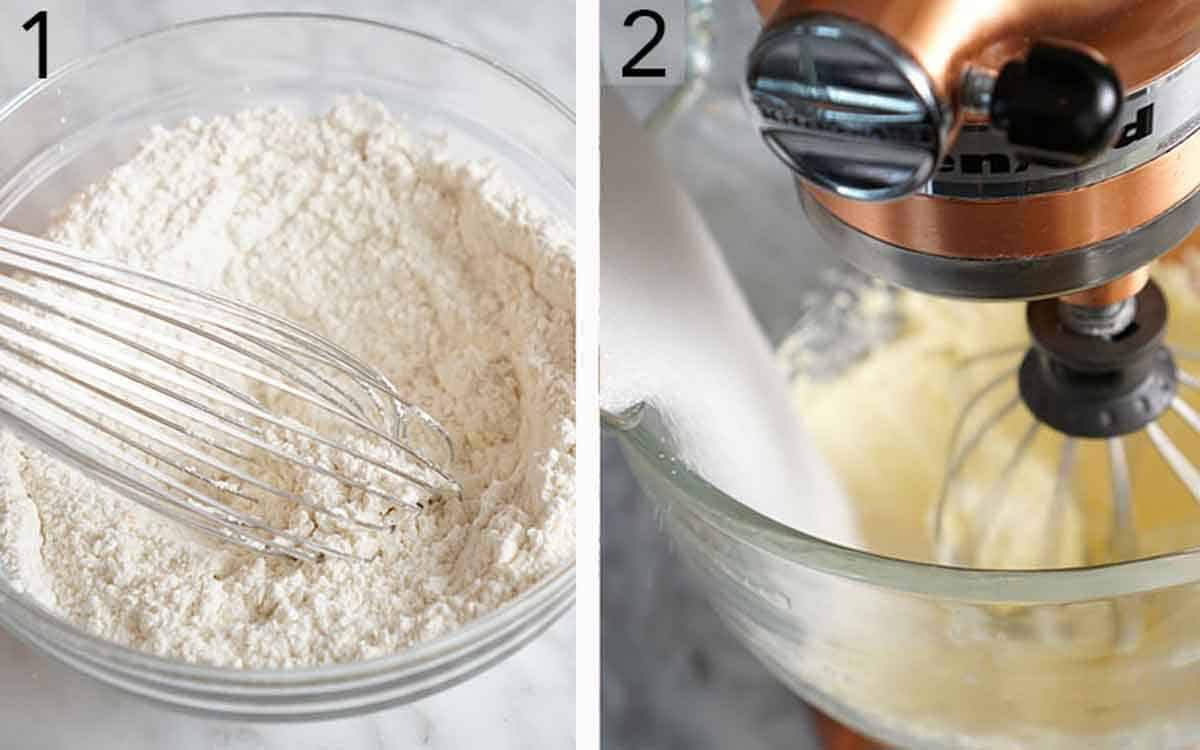
1. In a medium bowl, whisk together the all-purpose flour, salt, and baking powder, then set aside.
2. Cream the butter and sugar in a stand mixer fitted with a whisk attachment until light and fluffy.
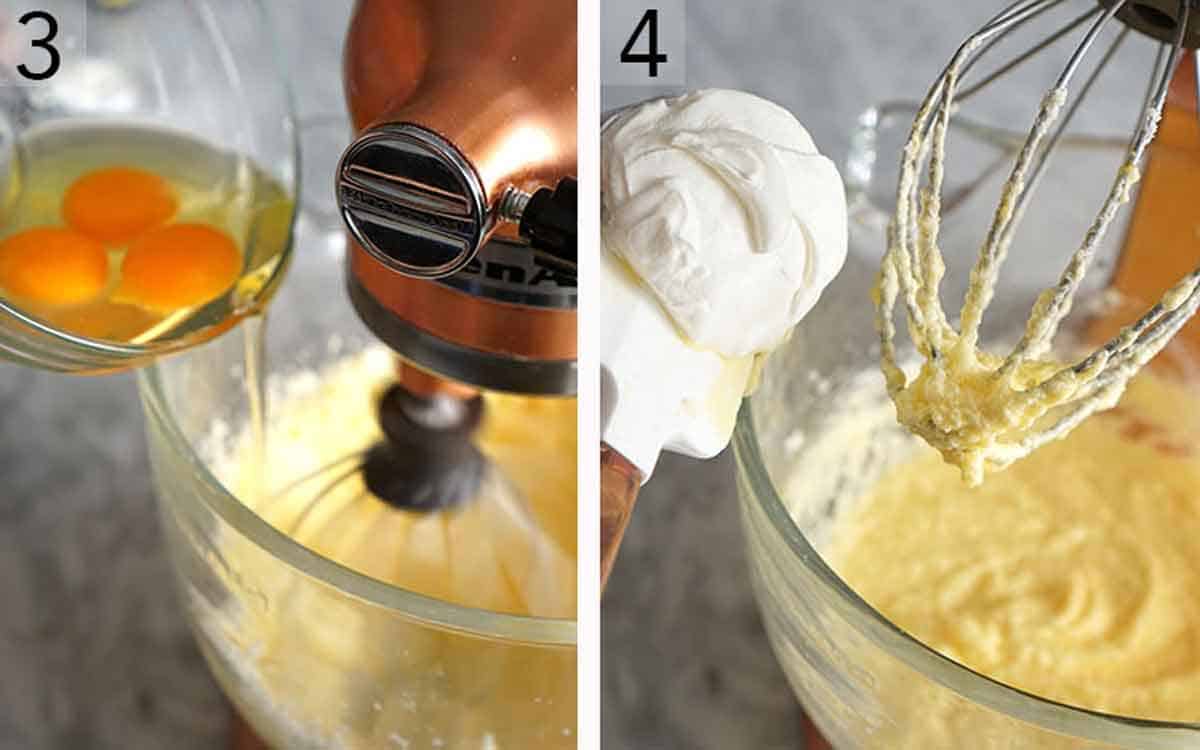
3. Add the eggs in one at a time while mixing at medium speed. Scrape the sides of the bowl down and beat until fully incorporated.
4. Add the sour cream and vanilla to the mixer. Mix until incorporated.
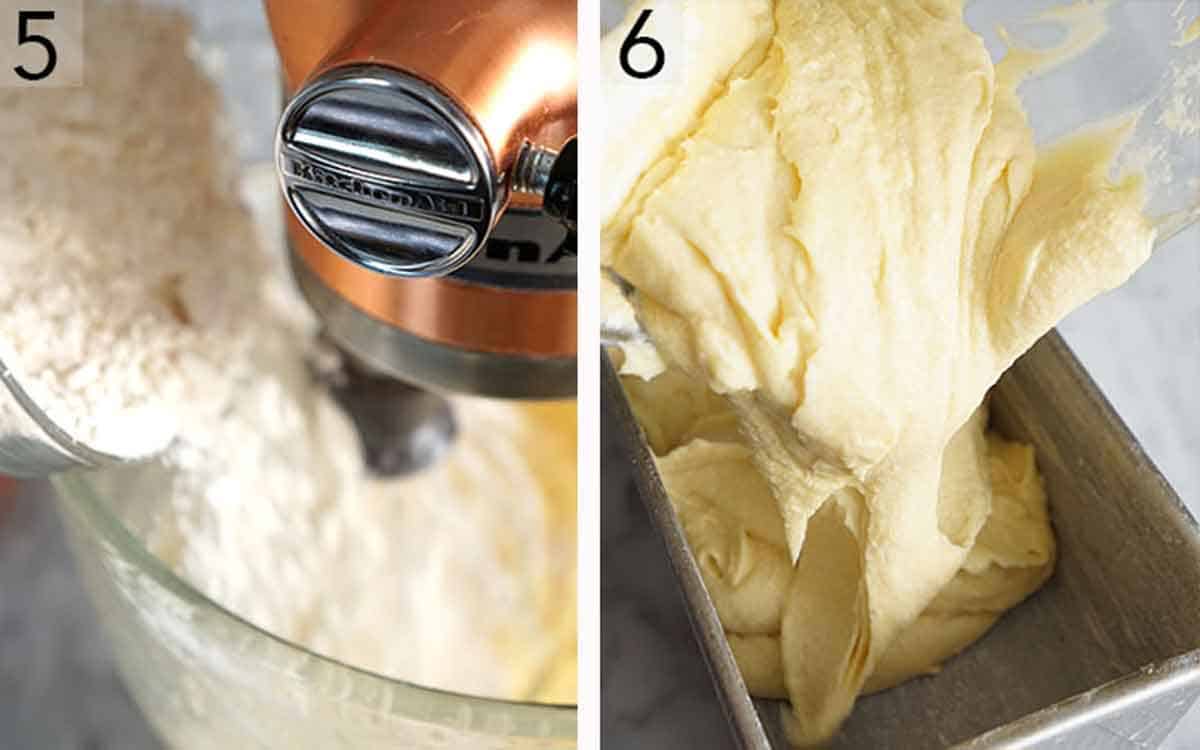
5. Add the flour mixture in and mix until combined.
6. Transfer batter into a loaf pan and bake for about 40 minutes or until the center is set and a skewer comes out clean. Allow the pound cake to cool in the pan for about 10 minutes before transferring to a wire rack.
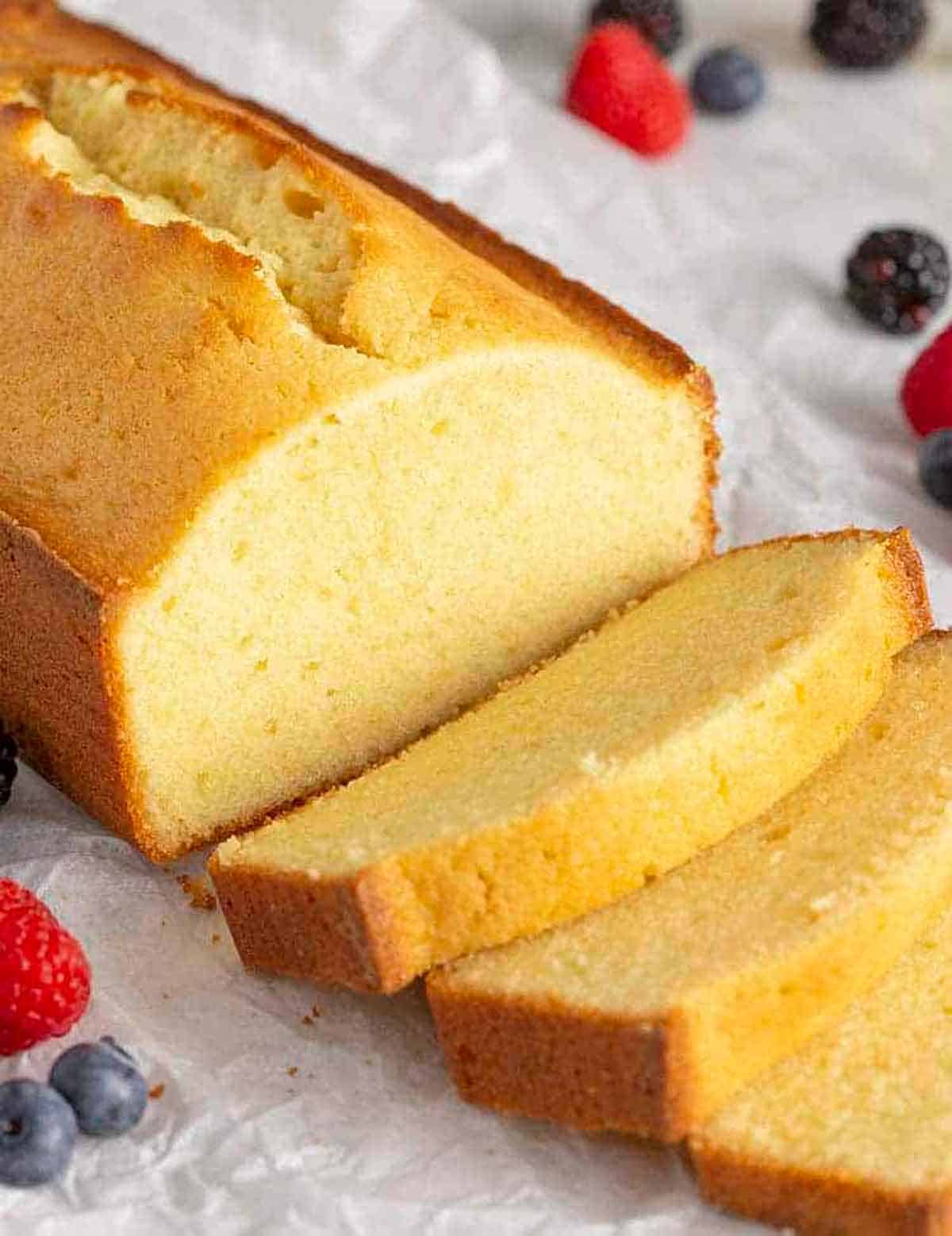
Double The Recipe To Make It In A Bundt Pan
Follow the recipes as directed, but double the ingredient amounts and bake it in a 12-cup Bundt pan or 10-inch tube pan. Butter and flour or grease the pan with baking spray right before you fill it with batter. You will also need to increase the baking time to about 1 hour and 15 minutes. Depending on the size of your pan, the bake time may vary, so start checking it after 1 hour. Let the cake cool in the pan for 15 minutes, then invert it onto a cooling rack and cool completely before slicing.
What Is The Secret To A Moist Cake?
The secret ingredient in this cake is sour cream. Do not skip it, as it adds a lot of moisture to the crumb. For best results, avoid overbaking the cake, or it will be dry. If you have leftovers, be sure to keep them wrapped or covered so the moisture stays inside of the cake.
How Do I Get a Crisp Crust On My Pound Cake?
The sugar content in a pound cake naturally makes a delicious, sweet, and crisp outer crust. To ensure it’s crisp and not soft, remove the cake from the pan after 10 minutes of cooling and finish cooling on a wire rack. If the cake cools in the pan, the crust will steam and be soft on the sides.
Why Is There A Gummy Streak In My Pound Cake?
If you have ever seen a thin line that runs through a pound cake, sometimes called a “sad streak” or “gummy streak,” it’s a sign that the pound cake batter was over-creamed. More specifically, the butter and sugar were beaten too much and too much air was incorporated. When the cake is baking, it will rise quickly but then fall when cooling, creating a streak of very dense cake that feels underbaked but is actually fully cooked- it just got compressed when it lost the air and sank.
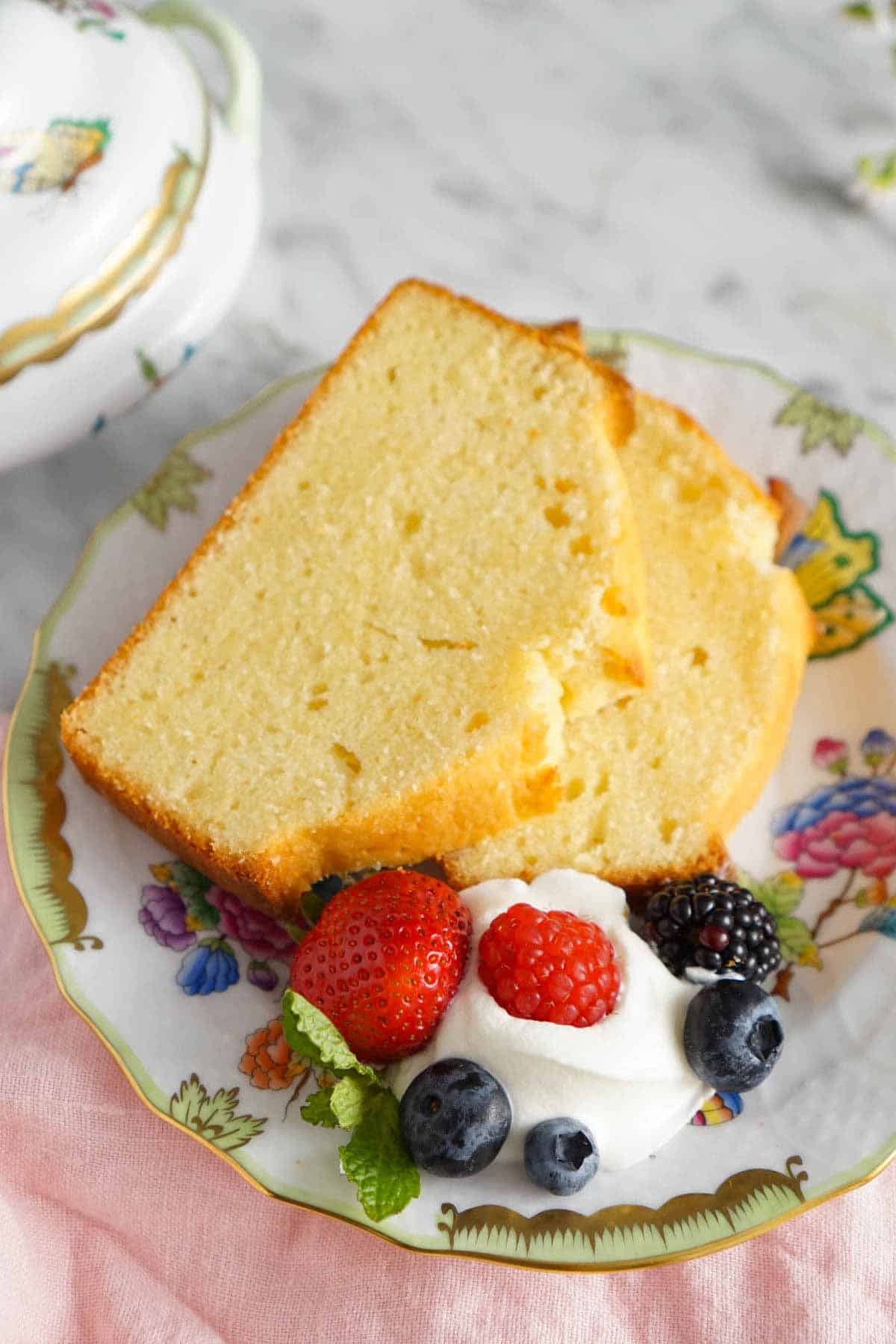
What Makes A Pound Cake More Dense?
When I talk about what makes a delicious cake, I often want a soft, moist, and airy crumb texture. Pound cake, on the other hand, is the opposite! Pound cake has a higher butter, egg, and sugar ratio to flour than many sponge cakes, and it uses much less of a leavening agent (baking powder or soda) in the batter, which creates less air. These factors all create a denser texture.
What’s The Best Way To Tell If My Cake Is Done Baking?
Use a wooden skewer inserted directly into the center of the cake, ideally through the crack formed on the top. You are looking for the wooden skewer to be removed without any streaks of wet batter on it. If it comes out clean or with just a few crumbs stuck to it, then the cake is done! If it has batter smears, then continue baking in 5-minute intervals and recheck between each one. Also, by inserting the skewer into the cake through the crack on top, you will check the spot that is potentially the most “underdone.” Plus, you won’t poke holes in your pretty sugary crust!
Can I Make A Lemon Version Of This Recipe?
You can easily flavor this pound cake with lemon by adding the zest of 2 lemons to the butter and sugar mixture before creaming it. Or, try my lemon pound cake recipe for more tips and tricks for baking the perfect lemony pound cake!
Pro Tips for Making This Recipe
- Should you line the pan? Up to you! You can simply grease and flour your loaf pan or line the pan with a parchment paper sling for easy removal. Both ways will back up great. If you are using a nonstick pan, I find the parchment isn’t really necessary.
- Use a long wooden skewer to check for doneness as the pound cake is so thick and dense that a toothpick will not get the job done. The cake will continue to bake while it cools, so be careful not to overbake it. Pull it from the oven when a few crumbs come out clean or with just a few crumbs on the skewer.
- Avoid overmixing the cake batter, as it’ll lead to a tough and rubbery cake.
- Measure your ingredients accurately. I highly recommend using a scale to measure your flour. However, if you don’t have a scale, be sure to fluff your flour with a spoon and then spoon it into your cups before leveling it off with a knife. This method is the best way to measure flour without overpacking the measuring cup.
- Use room temperature eggs. If you forgot to set out your eggs, quickly bring them to room temperature by placing them in a large bowl and covering them with warm tap water for 5 minutes. Room temperature eggs mix much more effortlessly into the batter.
- Do not adjust the oven temperature. While you may be tempted to speed up the baking with a higher oven temp, you do not want the cake’s exterior to burn before the middle bakes through.

Frequently Asked Questions
You can replace vanilla extract with almond extract for a change in flavor. You can also add juice and lemon zest or orange zest for a citrusy kick. Topping the pound cake with fresh fruit, nuts, or mixing in dried fruit is also an easy adaptation. If you love this recipe, then try my sour cream pound cake or blood orange pound cake too!
If you have leftovers of this easy pound cake recipe, cover the cake tightly, wrap it in plastic or store in an airtight container and keep it in the refrigerator for up to 5 days.
This cake freezes wonderfully. Wrap the cake with plastic wrap and then aluminum foil before freezing for up to 3 months. You can freeze individual slices of the cake as well. This method allows you to pull out cake slices as you crave them. Simply wrap them up individually in plastic and transfer the slices to a freezer-safe bag. Bring the cake to room temperature before enjoying it. Do not try to thaw frozen cake in the microwave or oven as it will dry out.
Traditionally, recipes used a pound of butter, a pound of sugar, a pound of eggs, and a pound of flour to make the batter, hence the name “pound cake.”
If you’ve tried this recipe, then don’t forget to rate it and let me know how you got on in the comments below. I love hearing from you!

Pound Cake
Video
Equipment
- 9×5 inch loaf pan
Ingredients
- 4 eggs
- 1 cup unsalted butter (226g) room temperature
- 1 cup sugar (200g)
- 1½ cup all-purpose flour (180g)
- ½ cup sour cream (120mL)
- 1 teaspoon salt
- 2 tablespoon vanilla
- ½ teaspoon baking powder
Instructions
- Preheat oven to 350F. Butter and flour a 9×5 inch baking tin.
- In a medium bowl whisk together the flour, salt, and baking powder then set aside.
- In a stand mixer fitted with a whisk attachment cream the butter. Add sugar in and mix until light and fluffy. Scrape the bowl down and beat a few more seconds.
- Add the eggs in one at a time while mixing at medium speed. Scrape the bowl down and beat until fully incorporated.
- Add the sour cream, and vanilla. Mix until incorporated. Scrape the bowl down.
- Add the flour mixture in and mix until combined. Scrape the bowl down and use your spatula to mix in any pockets of flour or butter that remain.
- Transfer batter into tin then give a quick smooth to even the batter out a bit. Bake at 350F for about 40 minutes or until the center is set and a skewer comes out clean.
- Allow to cool in the tin for about 10 minutes before transferring to a cooling rack.
Notes
- Should you line the pan? Up to you! You can simply grease and flour your loaf pan or line the pan with a parchment paper sling for easy removal. Both ways will back up great. If you are using a nonstick pan, I find the parchment isn’t really necessary.
- Use a long wooden skewer to check for doneness as the pound cake is so thick and dense that a toothpick will not get the job done. The cake will continue to bake while it cools, so be careful not to overbake it. Pull it from the oven when a few crumbs come out clean or with just a few crumbs on the skewer.
- Avoid overmixing the cake batter, as it’ll lead to a tough and rubbery cake.
- Measure your ingredients accurately. I highly recommend using a scale to measure your flour. However, if you don’t have a scale, be sure to fluff your flour with a spoon and then spoon it into your cups before leveling it off with a knife. This method is the best way to measure flour without overpacking the measuring cup.
- Use room temperature eggs. If you forgot to set out your eggs, quickly bring them to room temperature by placing them in a large bowl and covering them with warm tap water for 5 minutes. Room temperature eggs mix much more effortlessly into the batter.
- Do not adjust the oven temperature. While you may be tempted to speed up the baking with a higher oven temp, you do not want the cake’s exterior to burn before the middle bakes through.






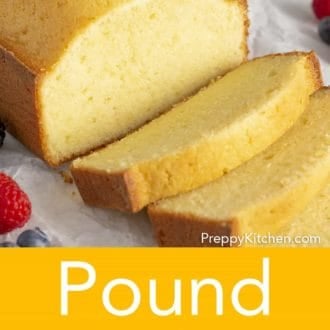
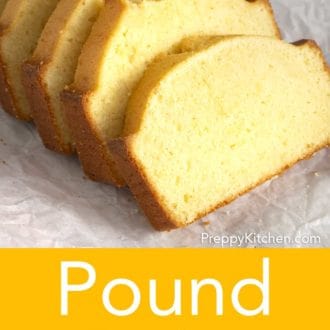


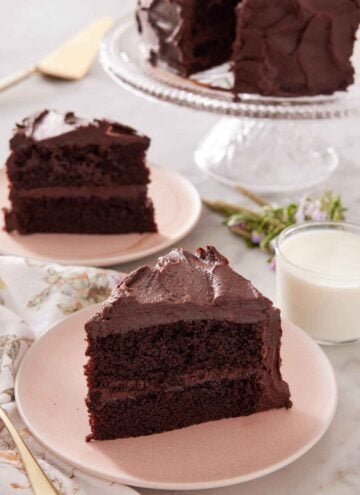



Wini says
Really the best pound cake
Thank-you
Mary says
I don’t understand why John won’t get his OLDER COMMENTS button fixed. I love to read COMMENTS and on all of his recipes, it will only show one page of COMMENTS. Makes me sad.
Naina says
Hey John, Did this recipe change recently to use sour cream instead of yogurt? I had tried it with yogurt and it came out nicely. Curious to know your reasoning behind the change! Planning to try it again this week, prefer it with yogurt as I usually have it on hand.
Sadi Sikander says
I have recently started following you and your recipes are Ah-mazing!!!
Love all your cakes as they come out as good as they are in your videos.
Thank you for these magical recipes!
Fan from Pakistan!!!!
John Kanell says
Thanks Sadi!
Michele says
Wow! Yummy ! This recipe bakes up just as deliciously pictured. This is the 5th recipe from preppy kitchen I’ve made and ALL of them have been super great!
Olga Bentley says
Delicious, fluffy, good texture … it came out of the oven and was finished in the blink of an eye.
Megha says
I m trying to cut down some sugar, is it possible to reduce some sugar without affecting the end goal. please please tell me if that is possible !!!
Michele says
I cut the sugar to 2/3 cup. No prob-was great. Perhaps complementing with ripe juicy fruit would add to the overall sweetness without white sugar? (Kiwi, blueberries, strawberries, melon, peaches?)
Janice Turner says
Fabulous! As easy as you made it look! I opted for rum flavour and added poppy seeds! A new favourite! Thank you!
Flowerchild57 says
I love pound cakes….This makes a delicious quick cake. I’lve eaten pound cakes all my life and I was really missing having some so I tried this recipe and it was perfect…and easy. Tks for the Yum!